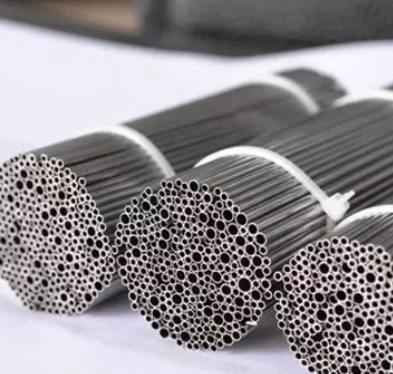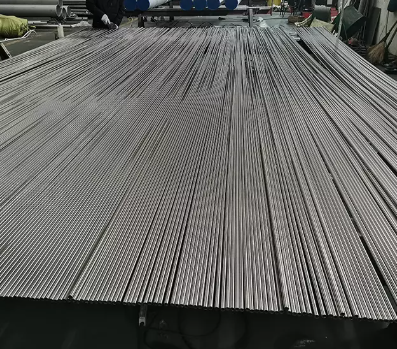close
Choose Your Site
Global
Social Media
Are you choosing between duplex and super duplex steel for your next project? Understanding the differences between these two materials is crucial for selecting the right one.
Duplex and super duplex steels offer unique benefits, particularly in industries like oil and gas, chemical processing, and marine applications. In this post, you’ll learn the key differences between these alloys and why choosing the right one is important for your success.

Duplex steel is a unique stainless steel alloy that combines both austenitic and ferritic properties in a two-phase structure. This structure includes equal parts of ferrite (body-centered cubic) and austenite (face-centered cubic), which work together to enhance the material’s overall strength and corrosion resistance. By offering the benefits of both steel types, duplex steel is a highly versatile material used in industries that demand both durability and resistance to environmental conditions.
Duplex steel contains a mix of key elements that provide its strength and corrosion resistance. Here’s a breakdown of its composition:
Chromium: A major component in duplex steel, chromium contributes to its corrosion resistance, particularly against pitting and stress corrosion cracking.
Nickel: Nickel enhances the ductility and toughness of the material, making it more flexible without compromising strength.
Molybdenum: This element adds resistance to pitting and crevice corrosion, making duplex steel ideal for chloride-rich environments, such as seawater.
Nitrogen: Nitrogen is crucial for enhancing duplex steel’s strength and improving its resistance to corrosion, especially in harsh environments.
Corrosion Resistance: Due to its high chromium and molybdenum content, duplex steel offers excellent resistance to corrosion. It can handle harsh environments such as seawater, chemical processes, and acidic conditions without degrading quickly.
Strength: The material's two-phase microstructure provides excellent mechanical strength, allowing it to withstand high stress. It is twice as strong as typical austenitic steels, which means it can handle heavy loads without adding unnecessary weight.
Cost-Effectiveness: Duplex steel is often more affordable than some other high-performance alloys. It offers a great balance between cost and performance, especially in environments where corrosion resistance and strength are required but at a lower cost.
Corrosion Resistance: Duplex steels excel at resisting pitting corrosion, crevice corrosion, and stress corrosion cracking. This makes them ideal for use in marine environments and chemical industries where exposure to corrosive substances is common.
Mechanical Strength: Duplex steel is much stronger than regular austenitic steels. It has a high yield strength and tensile strength, making it suitable for structural applications such as pipes, tanks, and pressure vessels.
Toughness: Despite its high strength, duplex steel maintains a good level of impact resistance. Its toughness allows it to perform well in environments where other alloys might fail due to stress or impact.

Super duplex steel is an upgraded version of duplex steel. It is highly alloyed with a higher content of chromium, molybdenum, and nitrogen, which gives it superior corrosion resistance and strength compared to standard duplex steel. Super duplex steel is specifically designed for extremely harsh environments, including those with higher chloride content or more aggressive chemicals, such as offshore oil rigs and chemical processing plants.
Super duplex steel differs from duplex steel mainly in its alloy composition. It contains:
Higher Chromium (up to 25%): The increased chromium content provides better resistance to pitting and crevice corrosion in chloride-rich environments like seawater and industrial chemicals.
Increased Molybdenum (up to 5%): Molybdenum further boosts resistance to localized corrosion and stress corrosion cracking, especially in acidic and chloride-laden environments.
More Nitrogen: Nitrogen strengthens the steel and increases its resistance to corrosion and strength. It stabilizes the austenite phase, which improves mechanical properties.
Nickel: The addition of nickel makes super duplex steel more ductile and tough while retaining high strength and corrosion resistance.
The Pitting Resistance Equivalent Number (PREN) is a corrosion resistance index used to compare duplex and super duplex steels. PREN takes into account the content of chromium, molybdenum, and nitrogen in the alloy. Super duplex steel typically has a PREN greater than 40, indicating superior corrosion resistance compared to duplex steel, which typically has a PREN of around 34. This makes super duplex steel highly effective in corrosive and extreme conditions.
Enhanced Corrosion Resistance: Super duplex steel’s increased content of chromium and molybdenum makes it highly resistant to pitting and crevice corrosion, even in highly corrosive environments like seawater and acidic conditions.
Higher Strength: Super duplex steel provides higher yield strength and tensile strength compared to duplex steel. This makes it ideal for applications where structural integrity is critical under extreme conditions.
Superior Durability: Its enhanced alloy content provides longer service life and better performance in challenging environments, making it suitable for industries such as oil and gas, marine, and chemical processing.
S32750 (Super Duplex 2507): Known for its exceptional resistance to chloride stress corrosion cracking and high strength.
S32760 (Super Duplex 2507 SAF): Often used in seawater applications and chemical industries where superior corrosion resistance is required.
Chromium: Both steels contain high levels of chromium, but super duplex steel typically has higher chromium content (up to 25%) compared to duplex steel (around 22%). This makes super duplex steel more resistant to corrosion.
Molybdenum: Super duplex steel has more molybdenum (up to 5%), further improving its corrosion resistance in harsh conditions.
Nitrogen: The addition of nitrogen in super duplex steel enhances its strength and corrosion resistance, stabilizing the austenite phase.
Super Duplex Steel: The higher levels of chromium and molybdenum give it superior corrosion resistance in aggressive environments such as seawater, acidic conditions, and chemical processing.
Duplex Steel: While duplex steel is resistant to pitting corrosion and stress corrosion cracking, it is not as resistant as super duplex steel in the harshest environments.
Super Duplex Steel: With higher yield and tensile strength, super duplex steel is stronger than duplex steel. This makes it more suitable for high-stress applications like offshore drilling and subsea equipment.
Duplex Steel: Duplex steel is still much stronger than austenitic steels, but it does not offer the same strength as super duplex steel in extreme conditions.
Welding Duplex Steel: Duplex steel can be welded easily using techniques like TIG or MIG welding, but care must be taken to control heat input to avoid unwanted phases like sigma phase.
Welding Super Duplex Steel: Super duplex steel is more challenging to weld due to its higher alloy content. Proper preheating and post-weld heat treatments are necessary to prevent the formation of harmful phases that can reduce its corrosion resistance.
Super Duplex Steel: Due to its enhanced alloy content, super duplex steel is more durable in extreme environments, such as offshore oil and gas exploration or chemical processing plants.
Duplex Steel: While duplex steel is resistant to many forms of corrosion, super duplex steel performs better in the most extreme conditions.
In conclusion, the key differences between duplex and super duplex steel lie in their composition, strength, and corrosion resistance.When choosing between the two, consider factors such as cost, application requirements, and the environment they will be exposed to.
By understanding these factors, engineers and procurement specialists can make informed decisions, ensuring the right material for each project’s needs.
A: The main difference is that super duplex steel has a higher chromium, molybdenum, and nitrogen content, offering superior corrosion resistance and strength compared to duplex steel.
A: Choose duplex steel for moderate corrosion resistance and cost-effectiveness. Opt for super duplex steel if superior strength and resistance to harsh environments are required.
A: Nitrogen enhances strength, improves corrosion resistance, and stabilizes the austenite phase in super duplex stainless steel.
A: Yes, duplex steel is generally more cost-effective due to its lower alloy content, though super duplex steel offers better performance in extreme environments.
A: Yes, duplex stainless steel is ideal for marine environments due to its excellent resistance to pitting and corrosion in seawater.